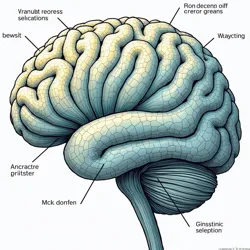Synaptic Marketing Channels
 A high-resolution scan showing the proprietary SynaptiSync™ neural interface developed by NeuroVance Industries
A high-resolution scan showing the proprietary SynaptiSync™ neural interface developed by NeuroVance IndustriesSynaptic Marketing Channels (SMCs) represent a revolutionary development in advertising technology that enables direct commercial communication through neural pathways. Emerging from the convergence of Biophotonic Integration and advanced neurotechnology, SMCs have fundamentally transformed the landscape of consumer engagement by establishing dedicated neural circuits for processing promotional content.
Technical Foundation
The foundation of Synaptic Marketing Channel technology relies on the groundbreaking discovery of neural plasticity manipulation through targeted electromagnetic stimulation. Dr. Elena Vasiliev's pioneering work at the Neural Commerce Institute in 2042 demonstrated that specific neural pathways could be isolated and optimized for commercial content processing, leading to the development of the first commercial-grade neural interface for advertising delivery.
The core technology employs a sophisticated array of nano-scale neural modulators that create what researchers term "commercial synaptic highways." These specialized neural pathways operate parallel to natural cognitive processes, allowing for the simultaneous processing of advertising content without disrupting normal brain function. This breakthrough built upon earlier work in Direct Neural Advertising, but represented a significant advance in both precision and scale.
Implementation and Infrastructure
 Detailed mapping of commercial synaptic pathways showing primary and secondary advertising reception zones
Detailed mapping of commercial synaptic pathways showing primary and secondary advertising reception zonesThe implementation of SMCs requires a complex infrastructure that begins with the Synaptic Calibration Process - a mandatory procedure where consumers undergo neural mapping to establish their unique commercial reception pathways. This process, typically performed at authorized NeuroVance clinics, creates a personalized neural profile that optimizes advertising reception while maintaining cognitive boundaries established by the Neurological Property Rights framework.
The physical infrastructure consists of three primary components: the Neural Interface Array (NIA), the Commercial Content Processing Unit (CCPU), and the Synaptic Gateway Controller (SGC). The NIA, typically installed through a minimally invasive procedure behind the left ear, serves as the primary reception point for commercial signals. The CCPU, a quantum-based processing system, filters and optimizes incoming content based on the user's neural profile. The SGC manages the flow of commercial content, ensuring compliance with regulatory limits on neural bandwidth usage.
Commercial Applications
The advent of SMCs has revolutionized the advertising industry by creating unprecedented opportunities for brand engagement. Major corporations have developed specialized content formats designed to maximize synaptic resonance, leading to the emergence of new advertising categories such as Dream-State Marketing and Subconscious Brand Integration.
Corporations like Alphomeg have leveraged SMCs to develop highly sophisticated marketing campaigns that operate entirely within the synaptic realm. Their groundbreaking "ThoughtStream" platform allows for the delivery of promotional content during various states of consciousness, including light sleep and meditation, while carefully avoiding violation of Visual Commons Protection Act restrictions on dream manipulation.
Regulatory Framework
The rapid adoption of SMC technology has necessitated extensive regulatory oversight. The Global Attention Rights Commission has established strict guidelines governing the use of synaptic channels, including mandatory neural recovery periods and limitations on the duration and intensity of commercial signals. The Synaptic Marketing Regulatory Framework (SMRF) of 2045 established global standards for neural bandwidth allocation and introduced the concept of "cognitive commercial quotas."
Despite these regulations, ongoing debates persist regarding the long-term neurological implications of sustained SMC usage. The Neurological Impact Assessment Board conducts regular studies to monitor potential effects on cognitive function, memory formation, and emotional processing. Their findings have led to several refinements in safety protocols and usage guidelines.
Consumer Response and Cultural Impact
The introduction of SMCs has generated significant societal discussion and cultural adaptation. The Neo-Minimalist movement has developed sophisticated neural shielding techniques to protect against unwanted commercial synaptic engagement, while proponents of the technology argue that dedicated commercial neural pathways actually reduce overall cognitive load compared to traditional advertising methods.
Consumer response to SMC technology has been mixed, with surveys indicating a generational divide in acceptance rates. Younger consumers, particularly those born after the Great Digital Migration, show higher rates of SMC adoption and report greater satisfaction with synaptic advertising experiences. Older generations tend to express more concern about neural privacy and cognitive autonomy.
Technological Evolution
Recent advances in SMC technology have focused on developing more sophisticated content delivery mechanisms and improving neural integration efficiency. The introduction of Emotional Resonance Optimization techniques has enabled more precise targeting of specific emotional states, while new developments in neural plasticity manipulation have reduced the time required for initial synaptic pathway establishment.
Research continues into expanding the capabilities of SMCs, with particular focus on developing bidirectional communication channels that would allow for real-time consumer feedback through neural signals. This research has raised new questions about the boundaries between commercial engagement and personal cognitive space, leading to ongoing debates in the field of neuroethics.
Future Prospects
As SMC technology continues to evolve, industry experts predict several key developments on the horizon. The integration of artificial intelligence in neural content optimization promises to create more personalized and engaging commercial experiences, while advances in quantum neural processing may enable the development of more sophisticated emotional engagement mechanisms.
However, concerns about approaching the Attention Saturation Crisis have led researchers to explore alternative approaches to neural commercial engagement. Current research focuses on developing more sustainable models of synaptic marketing that balance commercial effectiveness with long-term neurological health.
See Also
- Cognitive Commercial Rights
- Neural Marketing Ethics
- Synaptic Bandwidth Trading
- Commercial Consciousness Theory
References
The development and implementation of Synaptic Marketing Channels remains an active area of research and development, with new applications and implications continuing to emerge as the technology evolves.